Text
A workshop on Cosmotechnical writing
I gave a lecture on Cosmotechnical writing to the current masters students. It was mainly to help them with their own writing for their bios and artist statements for the final exhibition. I talked about my previous research: making predictions using the I Ching, my writing on the Chinese Typewriter as precursor for Chinese mobile phone typing systems, qi and dao and Taoist creation myths, String theory, Bitcoin and climate change, and shan shui painting.

I discussed how my visit to the Horniman Museum changed the direction of my work and I started to think of classification of technical objects using qi and dao as a possible topic. I showed them my five element classification system, and read the beginning of my essay. Writers I discussed included people like TJ Demos’ “Against the Anthropocene” and his lecture tour, Kathryn Yusoff’s “A Billion Black Anthropocenes or None”, and Yuk Hui’s “The Question Concerning Technology in China: An Essay in Cosmotechnics”.
I used my writing practice as a means to discuss possible ways of writing Cosmotechnically. I gave my own interpretation of the definition of performative writing, talking about the hybrid voices that were the main characters in my stories. They were conceived as symbiotic human computer entities, part of a larger collective network of voices. Various technologies and their users are given joint agency in my stories. I saw combinations of elements as constituent parts of these voices, who would act accordingly.
I outlined the problems with the Anthropocene thesis stating it aligns with accelerationist ideas that Capitalist implementations of a technological singularity can save us from the climate crisis. Also noting that it doesn’t take into account the position and rights of those most affected by environmental problems such as people of colour and other vulnerable groups.
I outlined Yuk Hui’s vision of multiple cosmotechnics and its support for looking to other cultures’ stories and theories as a means of analysing and realigning technology to make its relationship with nature more moral. Ways of writing cosmotechnically I put forward to the class included writing from the perspective of different technologies, thinking about how particular groups of people could use technology to make their lives better, and coming up with ways to oppose the misuse of a technology.
Most people chose to speak as if they were a particular technology, but a lot of interesting ideas were discussed. Some people chose to become machine learning algorithms and discuss through their working process, the relationships these have with authorities. Some looked at climbing and sports technologies. Others looked at multiple timelines as mediated by technologies. Many new cosmotechnical possibilities were presented and it got people thinking about how they could write in a different and more performative way. I enjoyed giving the class and finding out about everyone else’s ideas, as invariably they were new concepts I had not considered before.
References:
1. Yusoff, Kathryn; "A Billion Black Anthropocenes or None"; University of Minnesota Press, 2018.
2. Hui, Yuk; "The question concerning technology in China: An Essay in Cosmotechnics"; Urbanomic Media Ltd, 2016
3. Demos, T.J.; "Against the Anthropocene"; Sternberg Press, 2017.
0 notes
Text
Ideas for final piece
Perhaps I could change the sound of the narrative voice according to element or movement? The text could be moved in a different way. Is the text spoken or whispered? I could use the blow up spheres to project different images for different elements. One sphere could be devoted solely to generated text. A nature sound could be created when text comes onto the screen, changing according to movement. One thing to test early is how many screens can be added to Ubuntu.
youtube
The lantern installation by TeamLab is inspirational and reflects traditional aspects of Chinese culture. Perhaps I could use a Chinese lantern in my piece too.
Another idea would be to change the graphics so they are less two dimensional. If I used three.js I could introduce more 3D graphics and change the landscape backgrounds so that they look more like dioramas or panoramas. I thought of this when thinking back to worlds I created within shoe boxes as a child. Similar effects could be created within three.js using appropriate perspective camera views and landscape textures that are placed at different distances away from the viewport.
Reference:
https://www.wikihow.com/Make-a-Diorama
0 notes
Text
Notes from Deborah Levitt’s Volumetric Ecologies talk: Environments, bodies and mediated worlds.
Deborah Levitt from The New School in New York was the first speaker. She discussed her book “Rendering worlds” which looks at the affordances of emerging media and world-making when modelling cosmotechnical systems. Other books mentioned included “How life worlds work” by Michael Jackson, and “The Animatic Apparatus”, another of her books.
She discussed how new forms of animated digital life have interoperative vitality effects. In VR the image floats free of its bond to the real as the body becomes untethered from a biological or theological destiny. There are many forms of synthetic biologies including the oncomouse, the aliens in the “Avatar” movie, and even touched on the Sonic the Hedgehog character design controversy that was in the news recently.
She discussed how animation can produce a world, but not necessarily the world as we know it. It has a slightly different function to cinema which more often represents particular world views. Animation has the potential to model worlds and futures that we would like to happen. This is especially of relevance in our current situation. In this way animated worlds could be thought of as cosmotechnical.
Animation be used to mediate between the imperceptible aspects of computation and human perception. It can help us navigate in-between world of the pluriverse with multiple future potentialities, spaces where all can live peacefully together in conviviality and difference. Here she uses the pluriverse as a means of thinking beyond Western universality. Cosmotechnics is the unification of the cosmic order and the moral order through technology. Technology integrates the cosmos into social ritualised practices. Cosmotechnics emphasises a re-evaluation of relationships between humans, technology, the environment and the cosmos which could help us think differently about ways to improve this world.
She briefly dicussed the Anthropocene and describes it as a global axis of time and synchronization that is sustained by a view of technological progress towards the singularity. For her to re-open the question of technology is to refuse this homogeneous technological future that is presented to us as the only option. Other futures are possible, we only have to think of them to start making them.
VR is a useful option for speculative worlding. It allows us to inhabit worlds different to our own. VR’s tight coupling between human sensorium and machine parts of systems enable us to think in new ways. The worlds can be realistic or more fantastical. The immersed user knows he or she is in an artificial world but the embodiment within this fantasy allows for more speculative thinking to occur. VR tracks the body’s movements to make its generated world more immersive. We can create a relationship between our own experience and the cosmological world referred to in cosmotechnics to create something new, perhaps something better than our current world.

VR can be used as a site for ethnographic field studies. For this she cites the example of Hyphen Lab’s piece “Neurospeculative Afro-feminism” which allows users to explore a fictional futuristic Afro-Carribean beauty and hair salon through VR. One audience member took offence at this use of VR stating that it was reproducing the colonial gaze, not allowing people from these communities to actively engage in these new speculative worlds to improve them and contribute ideas. This was vehemently denied by Hyphen Labs in their talk about this piece.
The discussion after the talks brought up a few interesting points. As Francisco Varella says: we live in environments and we live in worlds but they are not the same thing. Perhaps consciousness is a surplus of signification generated through the coupling of our sensory apparatus with a “virtual” environment. Buddhism, Daoism, or embodied practice are all very different from conscious or rational deliberation. VR as planetary computation: design with the planet in mind.
0 notes
Text
Entanglement and agential realism in an elemental universe.
An elemental universe is one where all matter exists as fluctuating combinations of one or more elements. If we were to observe these fluctuations in phases within matter, we would cut1 matter creating a temporary division of elements in order to learn something new about the object. What we observe would tell us about the object in its divided state, but it would not reveal how fluctuations between phases occurs. This would remain hidden as the act of observation itself would exclude this from being determined.
Changes in the elements could occur as a result of political interventions into phase shifting processes. Metals, such as lead in lead acid batteries, can be transformed into lightning with phase changes occurring at a subatomic levels. There has been a push for more lightning vehicles by conglomerates and authorities looking to fix the climate crisis with technology, whilst at the same time profiting from it. This has tipped the elemental balance towards lightning production, but has unseen consequences on entities close to lead extraction and recycling facilities. Their well being is compromised, a cost that is considered acceptable to those hoping to profit from sales of lightning vehicles. The product that is supposed to help reduce environmental damage is simultaneously damaging its local milieu and those nearest its birthplace.
There are many other examples of this type of parasitic relationship in clean technologies, but they go unobserved as the cuts required to take heed of these injustices occur far from view and are thus not visible to those not looking for them. Perhaps it is not possible for the elemental balance to be restored in the current system. However if it is we would have to partially submerge our identities2 and become part of the larger collective Capitalist infrastructure, effecting phase changes from within using multiple small but focused interventions. These interventions would need to block the flow of water through the system, and disrupt potentially harmful phase changes, to slowly bring back elemental balance through a coordinated series of measured actions. Collective entanglement within the system is a necessary first step to changing the system.
References:
1. Barad, Karen; "Meeting the Universe Halfway: Quantum Physics and the Entanglement of Matter and Meaning."; Duke University Press Books, 2007.
2. Braidotti, Rosa; "The Posthuman"; Polity Press, 2013.
0 notes
Text
“A Billion Black Anthropocenes or None” by Kathryn Yusoff - interesting points
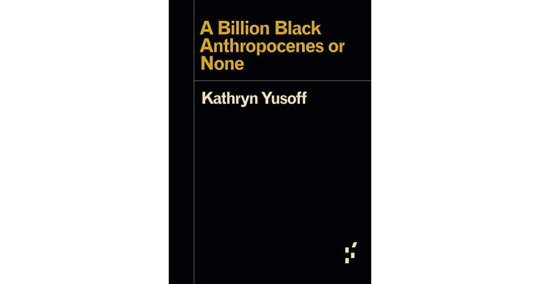
The golden spike is where the Anthropocene era is meant to have begun. Who gets spiked by geology? What colour is the flesh of geology? There is a shadow geology of disposable lives, waste, toxicity, contamination, extinction and exhaustion. The Anthropocene creates a planetary genesis tying human actions to the beginning of an epoch. In this theory human agency is a substitute for geologic process.
However geology is a subjective mode of the human, and can be thought of as a universal model of material agency with mastery over geologic processes. Originary geologic happenings reproduce power structures in the present through historical materialities.
According to theorists and scientists the Anthropocene is not yet ended, and it reorganises understandings of ongoing events. You could think of origins as accounts of agency or trajectories of power. Geology is a transactional zone where origins, subjectivity and matter intertwine.
When looking at environmental issues we should investigate the genealogy of dispossession, uprooting and extreme violence that so often co-exists with this crisis. Humanity has not understood the violent repercussions of colonialism, industrialisation, or capitalist production. A W.E.B. Du Bois quote illustrates this idea: "Whiteness as ownership of the Earth for ever and ever".
Eco-optimism and geoengineering indicate a desire to overcome coloniality without relinquishing the power to decide our future. The colonial assumption for the responsibility of saving the world is rearticulated as white man's burden, a paternalism tied to a redemptive and seemingly innocent saviour narrative. However are we merely living off the cumulative hurt of others?
Reference:
1. Yusoff, Kathryn; "A Billion Black Anthropocenes or None"; University of Minnesota Press, 2018.
0 notes
Text
“We live in an ocean of air”, other gallery visits, artist research and ideas for titles.
I went to see the interactive virtual reality exhibition “We live in an ocean of air” today. It left a deep impression on me with its flocking branches, swarms of particles forming branches, breath and foliage. It reminded me of an ancient tree with deep roots and energy running through its veins. This was analogous to the processes present in all life. Networks of branches and roots formed as you swirled in the space.
youtube
I also went to see Bill Viola and Michelangelo at The Royal Academy. I was struck by the elemental aspects of the work, as these were relevant to my own practice. There were videos of people underwater breathing, the image of them rippling, with bubbles rising. The bubbles and water travelled upwards and the images rippled when underwater. Fire was reflected in the water. The reflection line dividing some of the images had bubbles travelling away from the line, and ripples distorting the image. I found the portrait video works with fire or bubbles travelling upwards especially interesting. Perhaps similar imagery could be the starting point for some of the graphics for my work.
vimeo
Norimichi Hirakawa | datum, 2017, Moerenuma Park, Sapporo, Japan from norimichi hirakawa on Vimeo.
Norimichi Hirakawa’s digital works are chaotic and glitchy generative pieces, but their form and colour schemes are sometimes reminiscent of nature or the cosmos. This is work that could inspire the graphical aspects of my work in progress.
Related to my interest in using tai chi in my work is the Malay rituals art archive. It has video documentation of many different dances and rituals used in Malay culture. It also has a lot of image documentation of traditional performance forms such as Mak Yong Malay dance drama, and Teochew puppetry.
Possible titles for my essay could be:
“Exploring an elemental classification of internet and geotechnologies through five Cosmotechnical fables” or “Five Cosmotechnical fables exploring the Chinese environment through an elemental classification of technology”. One possible idea would be to maybe use Google Earth data in imagery for the work in progress piece.
References:
http://counteraktiv.com
https://vimeo.com/user14378708
https://medium.com/digital-art-weekly-by-danae-hi/18-museums-boosting-the-scene-of-digital-art-f8a4b4fa5eb9
https://www.pusaka.org/
https://joanielemercier.com/projects/
0 notes
Text
Work In Progress Ideas
I could make an artwork where it is possible to perform element bending for each of the different elements. Different shapes (possibly shown through gestures) could represent different elements:
Wood: rectangle,
Fire: triangle,
Earth: square,
Metal: round,
Water: wavy.
In choose element mode (could randomly choose element by "throwing" yarrow sticks) you can draw one of the shapes to pick an element. Drawing using your hands enables you to bend the element you are using at that time.
A throw motion is like a very short sentence. It will give you a short answer (like an element, or a line of poetry relating to a particular element). A longer drawing motion is like saying something that takes more time. It will give you a few sentences (like a verse of poetry of a few lines).
The slower you draw, the more visual and sound feedback you get. If you draw quickly, things happen but disappear fast, and sound is minimal. If you draw slowly, more things happen, and sounds gets more complex perhaps?
Tai Chi movements could create special effects on the screen. The landscape screen could be split into 5 vertical strips, one for each element. As each element story is told, a timeline graphic shows you where in the story you are, and travels horizontally across all 5 strips. The background is different for each element strip, perhaps different vertical shan shui landscape paintings ever changing.
I could use different voices for different narratives. The starting voice might be technological and louder as compared to firey or watery or elementally voices reading out machine generated text. This might occur just after a hand interaction occurs, and would be softer in volume.
0 notes
Text
TJ Demos – Against the Anthropocene. The Many Names of Resistance
vimeo
T.J. Demos | Against the Anthropocene from Kaaitheater on Vimeo.
How do we critically reflect on climate change through the arts? TJ Demos’ previous books include “Decolonising Nature” and his latest book “Against the Anthropocene”. His latest book has a more activist stance. The term Anthropocene coined in the early 2000s. The term supported a strongly technical and scientific sense, with not much in the way of political discussions. This proved problematic for TJ Demos, hence his polemical work “Against the Anthropocene”.
There is no such thing as discrete human subjectivities, we are connected to nature and enmeshed with it. Anna Sing’s book “Multispecies Salon” argues this. The term Anthropocene looks more at humans only, and in general as being responsible for climate change. However it is not all humans, but particular ones that are responsible for climate change. Some have been more adversely affected depending on wealth, poverty, class, gender, race etc. There is a disproportionate impact of climate change depending on who and where you are.
“Climate change represents the burning of Africa.” - TJ Demos
Political conference delegates agree on 1.5 degrees celcius warming, but this would be catastrophic for people in coastal regions in Bangladesh for example. There is a suggestion that geoengineering may be a necessary response to climate change. Technofixes for climate change deals with the symptoms but not the causes. Economic growth is seen to be compatible with climate solutions, but is this belief true? The Capitalocene these argues that climate change has been going on for 500 years, but if we are to address it properly we need to address this capitalist history.
The dates of the Anthropocene are proposed to have begun in the 1950s by geologists. This is when nuclear power was globalised. The book “Anthropocene or Capitalocene” edited by Jason W. Moore, rejects technoscientific empiricism in favour of looking at the cause from a political, colonial perspective. Capitalocene emphasises environmental violence and injustice against oppressed people and nature. Intersectionalist discussions look at the racial and colonial injustice that has accompanied the environmental transformation.
Forensic Architechture has also looked at the Capitalocene. Eyal Wiseman suggests that environmental transformation or climate change is not an unintended accident, but rather an intended aim of colonialism from the start. TJ Demos helped set up the Centre for Creative Ecologies to encourage this research and discourse. There is a risk of environmentalism becoming a privileged domain. In his view it needs to be linked to social justice domains. Environmentalism must not become a white domain, it needs to be intersectionalist and support social justice.
The Cthulucene: a term coined by Donna Haraway, from her book “Staying with the Trouble”. Linked to HP Lovecraft’s Cthulu, without the sexist undertones. Diverse mythological constructions such as naga, pachamama, or mother earth. Cthulucene is the era of multiscpecies being. Visualisations of the Cthulucene have been created by artists such as the Crochet Coral Reef. They sometimes show them as bleached to emphasise their destruction. Also shown are Navajo weaving and Pigeon Ring.
We need many names. A “Manifesto for the Gynecene” was an idea by artists Alexandra Pirici and Raluca Voinea in 2015. They proposed that patriarchy should be excluded in all its violent expressions such as colonialism, profit etc. Practices such as pachamana and rights of mother earth come out of indigenous traditions which are an example of the Gynacene. Defend Our Mother was an example of a poster by Fabiana Rodriguez, Gynacene aesthetics. Standing Rock against Dakota Access pipeline: “Water is life” proposing a different ontology based within a non-capitalist, non-commoditised understanding of environmental issues. Geontology is seeing the conditions of being as rift zones where different world views come into a clashing relationship.
Mountain top removal mining is when companies blow up mountain tops to get at coal underneath. Plantationocene is where agriculture has been turned into a science of colonialism. Anna Sing shows how divisions between genders and races are regimented into Capitalist labour systems, within a monocrop area. Plasticene is about the spread of plastics and micropolymers throughout the world. This is only going to grow in the future. We are plasticising the planet. Plastic as a material of Capitalism. The Pyrocene relates to the spread of wildfires such as in California.
"A World at War" is an article in New Republic. Our only hope is to mobilise like we did in world war 2. They want to decrease the CO2 in the air to under 300 parts per million. But they are looking at it from only a technoscientific viewpoint, and not looking at the 500 year history of Capitalism and its effects on climate change. Communities of colour are more endangered by incinerators than others, their lives are seen as less important somehow. We must decolonise environmentalism. Avoid the ecologies of affluence of white environmentalism. Ecological struggles are really the struggle for universal emancipation.
Artistic project “Forest Law”, 2014, investigates decades of oil exploitation in the Equadorian Amazon by oil companies, drilling for oil and leaving oil by-products on the floor. Artists building solidarities and connections with social movements is crucial. “The Party of Others”, a political party that is non-anthropocentric and includes animals and others so they can have a political voice. Rosa Braidotti calls it developing a zoe-centred (animal or non-human) egalitarianism. “The Climate Games” included Inflatables to activate participants, creating space between activists and police. There is a history of the use of cobblestones in revolutions in France. Non-violent civil shutting down of coal mines, “we are nature defending itself”, avoiding the anthropocentrism of the nature/culture binarism. In New York “not an alternative” wrote a letter to museums to detach from fossil fuel funding. David Koch, a fossil fuel corporate figure, got kicked off the board of the American Natural History Museum. Liberate Tate have been doing performance interventions showing the cost of petrocapitalism, and got Tate to stop its association with BP: institutional liberation. Non-reformist reform, welcomes small steps but also recognises it is inadequate.
Discussion after the talk:
Sustainability as an empty signifier. It supports not ecological sustainability but economical sustainability. Post-representational system in which language is dead. Evidence doesn’t necessarily change minds, people become sensitive and embedded in their positions. Create art based within the affect of social justice. What is Art in the post-representational present?
Billionaires buying escape silos in case of catastrophic futures. Others cannot do this. “Breakthrough Institute” (setup by people such as Bill Gates and other corporate leaders) don’t talk about racism or economic inequality, they talk about saving humanity and humanism through geoengineering and saving humanity with all its inequalities intact.
Reference:
Demos, T.J.; "Against the Anthropocene"; Sternberg Press, 2017.
0 notes
Text
Essay Plan - initial ideas
An initial idea for my essay title is: “Towards a cosmotechnical classification of technical objects”. That’s quite a precise title. It might be better in the future to find a more poetic title. There will be five main sections to my essay, one for each element: wood, fire, earth, metal and water.
Wood or Spring will discuss the genesis of the internet, and how it helps to spread Capitalism and its concepts far and wide. This section will also look at environmental aspects of internet use and the polluting effects of associated internet technologies.
Fire is associated with Summer. Lithium ion batteries and the environment could be explored here.
Earth is associated with Midsummer. Extraction of rare metals for technologies could a focus for this section. They are used in consumer electronics, electric or hybrid vehicles, wind turbines, magnets in weapons systems or aircraft.
Metal is associated with Autumn. Bitcoin mining in China happens on a large scale due to their very cheap prices for coal powered electricity. Although there is a big move towards hydroelectric power in China, many Bitcoin mining farms have not yet converted to hydroelectric over coal-based electricity possibly due to cost. Bitcoin mining uses vast amounts of energy and contributes significantly to climate change because of this.
Water is associated with Winter. For this the story of The Three Gorges Dam might be relevant. Dams and other geoengineering projects in China are very popular with authorities. However they cause significant local environmental damage, uprooting of local residents and endangerment of animals and plants in the area.
Each element will have a different story. The different elements are also called phases, and change from one to the other in the order outlined above. I will keep this general order with the Wood or Spring story, telling the archetypal creation story of when computers (or hybrid computer/human entities) woke up. I will examine the invention of the internet through a cosmotechnical lens. The story will be analogous to Pangu, but about ARPA (from ARPANET) as the network that spawned the beginning of the internet.
I could look at how these technologies effect the environment and marginalised groups to see if there are similarities with Capitalism’s environmental aims in China to those in the US that TJDemos has outlined in his book and talks.
References:
https://en.wikipedia.org/wiki/Pangu
https://sociable.co/technology/tech-mythology/
https://www.weforum.org/agenda/2017/11/battery-batteries-electric-cars-carbon-sustainable-power-energy/
https://www.tandfonline.com/doi/full/10.1080/23812346.2018.1443758 ?
https://roskill.com/news/electric-vehicles-china-takes-steps-to-streamline-ev-battery-recycling/
https://edition.cnn.com/2018/10/30/business/europe-lithium-electric-batteries/index.html
https://en.m.wikipedia.org/wiki/Rare_earth_industry_in_China
https://theconversation.com/politically-charged-do-you-know-where-your-batteries-come-from-80886
0 notes
Text
TJ Demos: To Save A World
I went to a lecture at Goldsmiths by the renowned theorist TJ Demos. It was a very inspiring talk and encouraged me to look at geoengineering and the idea of the Anthropocene in very a different way. Here are some photos I took during the talk, with a few thoughts and comments.

A packed lecture hall for T.J. Demos’ talk: “To Save A World”.
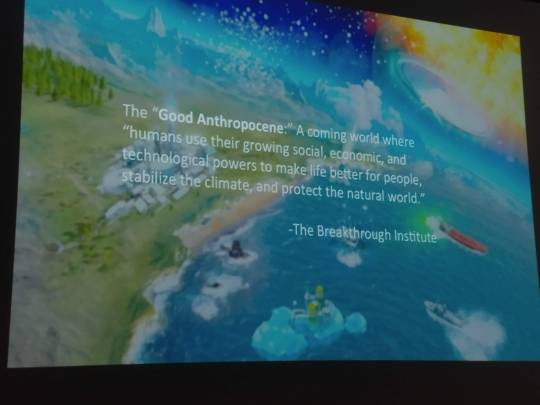
Demos talks about “The Breakthrough Institute” as an example of a Capitalist, anti-green, pro-nuclear think tank in the US. Their agenda is to promote technological and geoengineering “solutions” to climate change, here speaking about the oxymoronic concept of the “Good Anthropocene” as a way of rebranding climate change as an opportunity for positive “ecomodernist” technological intervention. This of course utilises the term “Anthropocene” which generally refers to climate change produced as a result of human-centred activities. However here the rift between humans and nature is not harmful in its foregoing of any harmonious relationship with the environment, and instead their message highlights how nuclear power and shale gas could usher in a consumerist technological utopia. This message is clearly at odds with current scientific and theoretical thinking regarding humans, Capitalism and the Anthropocene, which paints an altogether less rosy picture.

The following photos illustrate aspects of the “Ecomodernist Manifesto” and “The Breakthrough Institute’s” role in furthering this damaging Capitalist vision of the future. Their message essentially ignores root causes of climate change and ecological crisis, instead using them as an excuse to promote technological and geoengineering profit making endeavors. The cost of these technological solutions, however, is often greater inequality.

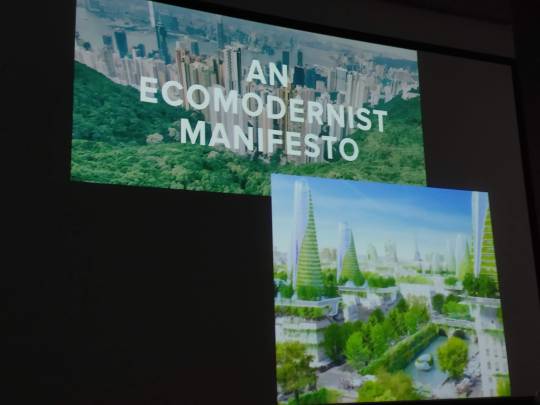
Defining the Anthropocene period:
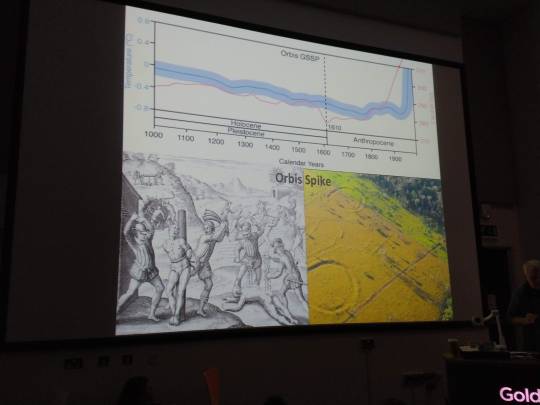
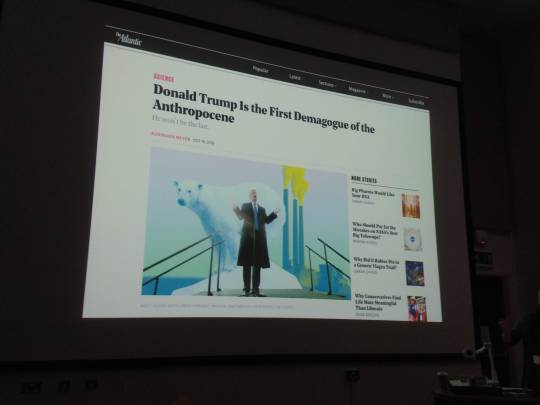
Still from Arthur Jafa’s “Love is the message, the message is Death”. Here he is linking civil rights movements and the historical experience of black people to the cosmological and Sun Ra. Below this photo is a video of the artwork.
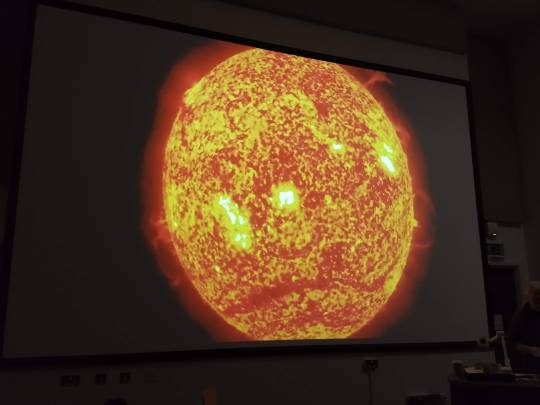
youtube


The photo below is of the Breakthrough Institute disagreeing with Naomi Klein’s thesis from her book “This Changes Everything”. In this book she poses the idea that action is needed to counteract climate change beyond Capitalism endorsed technological fixes, something the Breakthrough Institute clearly does not agree with.
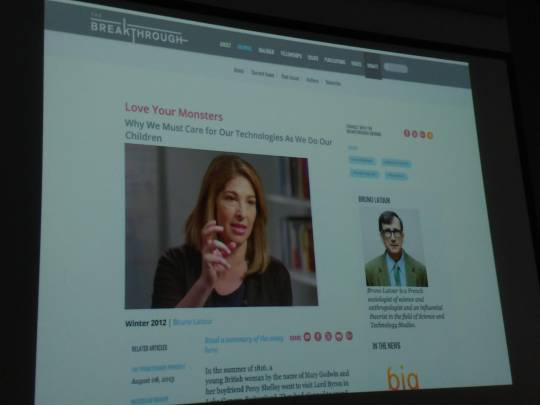
Some photos depicting environmental activist resistance movements by minority communities:
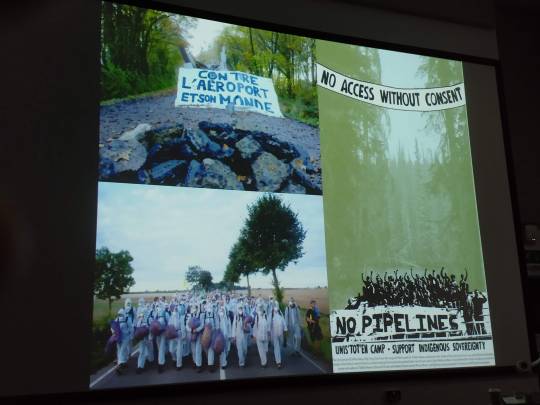
Geoengineering as the saviour of the Anthropocene is here rightfully questioned, but at the same time another technological solution is offered in its stead:

Afro-futurism and climate change, and Arthur Jafa’s idea of the “abject sublime” or the beauty and horror of lived black experience:


Sun Ra and Afro-futurist imagery.

The Neoliberal Anthropocene is a term showing the connection between the current hegemonic state of Neoliberalism and the theory of the Anthropocene. The two are connected and feed off each other helping to create the illusion that money and technology are enough to fix climate change.
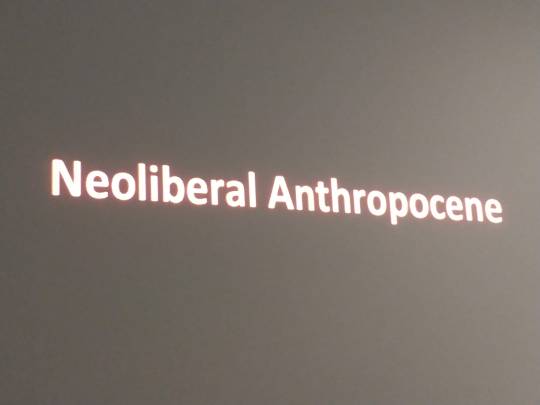
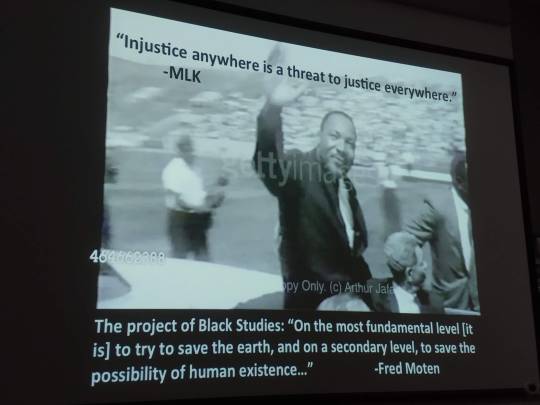
References:
https://www.resilience.org/stories/2015-05-20/hijacking-the-anthropocene/
https://www.e-flux.com/journal/94/221148/to-save-a-world-geoengineering-conflictual-futurisms-and-the-unthinkable/
Klein, Naomi. "This Changes Everything : Capitalism vs. the Climate." New York :Simon & Schuster, 2014.
0 notes
Text
Selections from Iniva's More-than-human Care book list:
Sci-fi paganism / Lucy A. Sames, Plastique Fantastique, Cathy Haynes, Sam Austen, Lawrence Lek, Dean Kenning, Sovay Berriman, Rowena Harris.
By: Sames, Lucy A [curator].
SF : speculative fabulation and string figures = SF : spekulative fabulation und string-figuren / Donna Haraway
By: Haraway, Donna.
The re-enchantment of the earth : a project for Interzones.
CD
Decolonizing nature : contemporary art and the politics of ecology / T.J. Demos
By: Demos, T. J
Forensis : the architecture of public truth / [a project by Forensic Architecture, Centre for Research Architecture, Department of Visual Cultures, Goldsmiths, University of London].
By: Forensic Architecture (Project)
FutureNatural : nature, science, culture / edited by George Robertson ... [and others].
Contributor(s): Robertson, George
Futures and fictions / edited by Henriette Gunkel, Ayesha Hameed and Simon O'Sullivan.
Contributor(s): Gunkel, Henriette [editor.] | Hameed, Ayesha [editor.] | O'Sullivan, Simon, 1967- [editor.].
Hybridity and its discontents : politics, science, culture / edited by Avtar Brah and Annie Coombes.
Contributor(s): Brah, A | Coombes, Annie E
Immersed in technology : art and virtual environments / edited by Mary Anne Moser with Douglas MacLeod for the Banff Centre for the Arts.
Contributor(s): MacLeod, Douglas | Moser, Mary Anne | Banff Centre for the Arts
Lee Bul : monster + cyborg / edited by Kuroda Raiji
Physique of consciousness : spiritual fitness / Alexia Dehaene, Chen Si, Renee and Xu Yingjie
Contributor(s): Madeln Company, China
Ambient information systems / Luksch/Patel
Art as Environment : a cultural action at Plum Tree Creek : mending the broken land with water / [Wu Mali, curator]
Art in the Anthropocene : encounters among aesthetics, politics, environments and epistemologies / [edited by Heather Davis and Etienne Turpin].
Contributor(s): Davis, Heather M. (Heather Margaret) [editor.] | Turpin, E. (Étienne) [editor.]
Concerning the spiritual in contemporary art/
By: Hoskote, Ranjit.
When species meet / Donna J. Haraway.
By: Haraway, Donna Jeanne
0 notes
Text
Some research into relevant exhibitions and programming experiments referencing technology, Bitcoin and Chinese mythology.
The Open Codes exhibition which is held yearly at ZKM in Germany is interesting because of its open cross-cultural emphasis on code as a tool for creation by many creatives and technologists in an environment of interdisciplinary collaboration and co-creation. It emphasises the non-linearity and multi-layered form that knowledge production takes. This reminded me of the many different ways in which knowledge can be produced, not just within the university or academy setting. Many different non European and indigenous cultures have their own forms of knowledge, mythologies and philosophies that are rarely spoken of in more traditional academic circles. In this way I feel that Chinese mythology can help us think about the way in which we live with technology and its effect on the environment. It could be a novel way of qualitatively analysing the effects of technology on its users and the authorities that subvert its power.
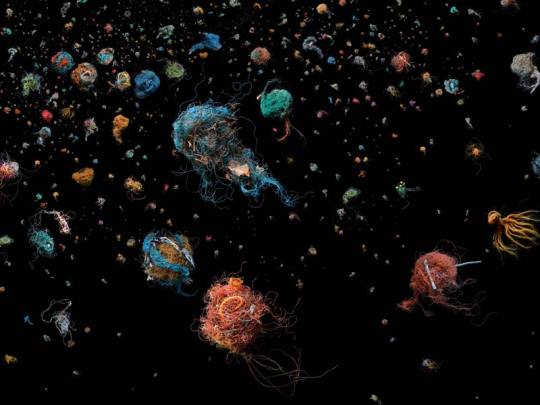
Mandy Barker creates photographs of subsections of plastic waste from the ocean that escapes recycling or landfill. She then overlays, arranges and photographs them in compositions that make them look like they are floating in a void. Her aesthetic encourages viewers to reflect on their own social responsibility to the environment as objects include plastic toys, retail items, household and even hazardous waste relating to the retail and material culture of Hong Kong.
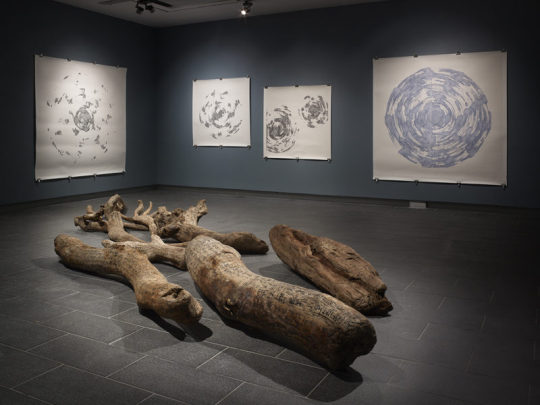
Charweu Tsai makes artworks about indigenous communities in Taiwan and the impact of external environmental and social factors. She symbiotically relates contemporary sustainable practice to traditional spirituality and beliefs.
Is it possible to forecast Bitcoin prices using Deep Learning algorithms and feeding it historical data? Unlikely, as there are probably many other factors involved not accounted for in the feeding data. This has not stopped people from trying, albeit with big disclaimers about its reliability.
If we were to classify technology into 3 different categories what could these be? Possibly: tools (gadgets), products, processes; or: information technology, assistive technology, or medical technology? How could a five element based classification of technology work?
References:
https://zkm.de/en/exhibition/2018/04/open-codes-digital-culture-techniques
http://cfcca.org.uk/exhibition/mandy-barker-hong-kong-soup/
http://cfcca.org.uk/exhibition/charwei-tsai/
https://medium.com/activewizards-machine-learning-company/bitcoin-price-forecasting-with-deep-learning-algorithms-eb578a2387a3
0 notes
Text
Critical Studies session notes
One of the books discussed in the course of feedback on our current research and ideas included: Eric Horl’s “General Ecology: The New Ecological Paradigm”. This looks at ecological paradigms noting that there are thousands of ecologies, which may or may not have anything to do with nature. In fact it is the unnatural which holds sway over the natural in what Horl describes as a “technoecological condition”. He notes that the wide distribution of technological sensors into the environment contributes to the development of a new rational power axis across the world. He posits an “alternative thought of nature that is no longer based on the operation of division” eschewing binary conceptions of nature and technology for a multiplicity of entities or a technological assemblage incrementally becoming ecological worlds with delicate interconnections.
This idea of a technoecological assemblage or multiplicity holds analogies to my burgeoning qi, dao and wu xing (five elements) technological classification idea. There seems to be a triad of qi/dao, Bitcoin and ecology at play in my interests. Perhaps one idea to pursue could include Bitcoin price data visibly and qualitatively changing the ecology or environment somehow. Or I could create a Taoist beginning of the Universe narrative piece relating to qi/dao classification, the five elements, technology and its effects on the environment.
Other related books and concepts: Lisa Nakamura’s “Indigenous Circuits” paper on women of colour’s labour in digital industries; “Fiction as Method” edited by Jon K Shaw and Theo Reeves-Evison; Wolfgang Ernst’s media archaeological approach to considering mobile media and new temporalities; “Futures and Fictions” edited by Henriette Gunkel, Ayesha Hameed and Simon O’Sullivan.
Some ideas formed whilst reading papers:
Tai Chi moves being used to harness the forces of nature eg fire, water, wind etc.
Most modern computational technology has the metal element in it.
If it is to do with communication of networks the technology also has the water element as a constituent.
Medical technology can be thought of as having the wood element.
Algorithms and computer programs can be thought of as mostly fire (synonymous with air in Ba Gua 8 element system).
Tools which are used to make things or produce things can be thought of as a combination of earth and wood.
Broken technology readings could be performed, to determine which element is out of balance, enabling the visitor to go out into the world and find that extra element and thus find balance and possibly fix the object (or themselves)?
Randomly select 5(?) pictures of technical objects. This gives you a reading of your elemental state and tells you which ones are out of balance.
Multiple monitor "oracle" giving "readings" based on technology images chosen by participant (like tarot readings, except these are element readings).
Create a grammar for chatbot-like behaviour. Users can get readings based on their technology selections (randomly or purposely made). The oracle then creates a hybrid technological species based on the user's selections which is made into new 3D model, image or computational art representing the technologies and associated elements. As well as this "recombinant" image (made through machine learning or genetic algorithm) the user also gets a text or audio "reading" from the oracle created spontaneously through machine learning or other computational processes (eg markov chain).
Can find out about the different elements and what they mean, the narratives and stories could be relayed in spoken sound pieces which are played when the relevant element is touched.
Is the interaction going to be screen-based or using another method eg a sensor such as leap motion, physical computing, voice activation or other sensor?
Wu Xing Oracle current interaction ideas: Click on a technology picture and in the centre the picture changes to show it. A Chinese style poem or reading is generated from a database of lstm machine learning created poems.
References:
https://lnakamur.files.wordpress.com/2011/01/indigenous-circuits-nakamura-aq.pdf
http://mediatheoryjournal.org/wolfgang-ernst-tracing-temporealities/
https://mitpress.mit.edu/books/fiction-method
https://repeaterbooks.com/product/futures-and-fictions/
https://www.coursera.org/lecture/religions-society-china/before-taoism-five-elements-and-five-phases-tvxyJ?authMode=login&errorCode=invalidCredential
http://www.poetry-chaikhana.com/Traditions/Taoist/
https://www.thoughtco.com/taoist-poetry-3183015
http://www.chinese-poems.com/subject.html
https://terebess.hu/english/tao/gia.html#Kap01
https://theapproach.co.uk/exhibitions/hun-kyu-kim/press-release/
0 notes
Text
Visit to the Horniman Museum

I visited the Horniman Museum on the weekend. Whilst there I saw the Natural History collection. This is a collection that first opened in 1901. It comprises mainly taxidermy, skeletons and fluid filled vitrines preserving specimens. The star exhibit is the large stuffed walrus atop an iceberg that sits proudly in the centre of the gallery.
youtube
Most of the specimens were collected over a century ago in the Victorian and Edwardian periods. This was a time when many collectors and scientists were going around the globe in search of different species.
Museums have a history of supporting the image of a glorious empire whose wealth of natural resources spans an empire. Often the countries whose plants and animals were being displayed in glass vitrines, had little say over how their natural resources and people were being exploited. Sir Hans Sloane was an example of this, as he used Ghanaian slaves to collect rare plant species for his collections. The slave trade was in this way linked to many natural history collections, occurring as it did during the beginning of the eighteenth century just as European colonialism was at its peak. Tea, coffee and chocolate trade expanded around this time too, with many indigenous people’s role in this whitewashed from history. Local guides shared their knowledge with explorers but were not credited with helping expand the field of scientific knowledge.
When looking around the collections of The Horniman Museum many examples of taxidermy are displayed making me wonder how these species were collected, and who was involved in this process. Apparently Fredrick Horniman, an English tea trader, collected these species to teach local people about the world. Initially he showed his collection at home, but when it outgrew this he continued to show it in a bigger building. The museum was first opened on Christmas Eve in 1890 and was called Surrey House Museum. It attracted 42808 visitors in its first year, whilst only being open for 110 days during that period. In 1898 Fredrick Horniman decided to upgrade the museum grounds as he felt the collection needed a better museum. He closed the Surrey House Museum in January 1898. He commissioned Charles Harrison Townsend to create the museum that he felt these collections deserved. The official Horniman Museum opened to the public in 1901 in a Grade II listed conservatory which had been moved from his family home in Croydon to the new grounds. Mr Horniman continued to contribute to the museum’s collections, eventually donating it and its collections and grounds freely to the trustees of London County council.
Looking at all the orderly classification diagrams I wonder if it would be possible to use Qi, Dao and Cosmotechnics as a basis for a classification system for technology. For example some objects could belong to different elements eg fire, wood, earth, metal, water etc. Technical objects might also be mainly one element, but also partly others. For example a network router might be mainly water because of its use in communication, but also metal and fire due to its physical composition (metal) and its innovative packet switching data transmission technology (fire).
References:
https://www.southlondonclub.co.uk/blog/a-brief-history-of-the-horniman-museu
0 notes
Text
Chinese Poetry sources
The Four Chinese Classics: Tao Te Ching, Analects, Chuang Tzu, Mencius Kindle Edition
by David Hinton
Bright Moon, White Clouds: Selected Poems of Li Po (Shambhala Library) 1st Edition, Kindle Edition
by Li Po (Author), J. P. Seaton (Translator)
Classical Chinese Poetry: An Anthology Paperback – 1 Feb 2010
by David Hinton
The Anchor Book of Chinese Poetry: From Ancient to Contemporary, the Full 3000-Year Tradition Paperback – 8 Feb 2005
by Tony Barnstone (Editor), Chou Ping (Editor)
Existence: A Story Paperback – 9 Aug 2016
by David Hinton (Author)
Chinese Through Poetry: An introduction to the language and imagery of traditional verse. Paperback – 22 Aug 2007
by Archie Barnes (Author)
The Heart of Chinese Poetry Paperback – 2 Aug 2008
by Greg Whincup (Author)
Lao Tzu: Tao Te Ching: A Book about the Way and the Power of the Way Paperback – 14 May 2019
by Ursula K Le Guin (Author)
https://www.microsoft.com/en-us/research/blog/the-poet-in-the-machine-auto-generation-of-poetry-directly-from-images-through-multi-adversarial-training-and-a-little-inspiration/
https://www.microsoft.com/en-us/research/publication/beyond-narrative-description-generating-poetry-from-images-by-multi-adversarial-training/
0 notes
Text
Strange Days, Memories of the future at 180 Strand
The first work you see on entering the exhibition is Camile Henrot’s “Grosse Fatigue”. Here is a video of her talking about this piece:
vimeo
Camille Henrot "Grosse Fatigue" from Collectif Combo on Vimeo.
It follows the point of view of someone opening and closing folder and browser windows on a computer desktop to show various images and videos. A hip hop style narrative runs over the top of the video. It is an amalgamation of different creation myths, comparing and contrasting them whilst showing relevant imagery. It was very inspiring to watch as it had a strong beat to it, whilst at the same time dealing with big mythological and scientific subjects concerning the creation of the universe as told in different cultures. The layering of multiple images, simultaneously and sequentially, gave the work an overlapping collage-like effect. I have been researching Taoist creation myths and noticed some similarities to these.
In Taoism the main creation or cosmogenic myth is the story of Pangu. In the beginning there was chaos. This coalesced into a cosmic egg within which yin and yang gradually became balanced. Pangu awoke and emerged from the egg. He created the world by separating yin (the earth) and yang (the heavens) from each other, holding them by standing between them and pushing up the sky. After 18000 years Pangu died and his breath became the wind and clouds, his voice: thunder, his eyes: the sun and moon, his head: mountains, his blood: rivers, his muscles: fertile earth, his beard: the stars and milky way, his fur: forests, his bones: minerals and diamonds, his sweat: rain, and fleas on his body became animals.
I would like to create some mythologies of my own analysing the evolution of technology. Using cosmotechnics I would like to create stories encompassing artificial intelligence, growing algorithmic control, capitalism and its effect on the environment. Researching different Chinese myths will be my starting point, but the characters and settings would relate to modern and historical technology and its effects on society.
Another work that interested me was John Akomfah’s piece Vertigo Sea. It is a filmic meditation on the use of the sea in slavery and migration, whaling, and the environment. Spanning three screens it uses archive footage from the BBC’s Natural History Unit as well as newly filmed material. The scenes it presents show the sea in all its majesty and horror. Slaves are shown being shipped across the waters, some tragically drowning and being killed. The whaling industry is shown hunting their prey, juxtaposed with images of these beautiful creatures making their way across the deep blue sea. Floating icebergs are depicted, reminding me of the dangers inherent in crossing the sea, as well as the environmental peril we have inflicted on ourselves.
youtube
What struck me was his careful use of overlapping and juxtaposing imagery across the screens, and their role in the unfolding narrative of the piece. Poems and writings such as Melville’s “Moby-Dick”, works by Virginia Woolf and Heathcote Williams “Whale Nation”, overlay the imagery providing a literary commentary to the on screen drama. This is perhaps a tool I might need to use in my own work, although as yet I am unsure of the exact details I might utilise. Some of the themes of nature in distress are similar to my own, but the stories I plan to create will be quite different in tone.
References
https://en.wikipedia.org/wiki/Chinese_creation_myths
https://en.wikipedia.org/wiki/Pangu
https://www.theguardian.com/artanddesign/2016/jan/25/john-akomfrah-vertigo-sea-bristol-arnolfini-london-lisson-gallery-auto-de-fe-the-airport-tropikos
0 notes
Text
Civilisations - Picturing Paradise
I saw this documentary from the BBC on iPlayer. It had an interesting section on Chinese landscape painting and the narratives and meanings inherent in their compositions. Nature and landscape art are suggested to be an antidote to man’s anarchy, a vision of how we would like things to be. Landscapes show us harmony between nature and man, and depict our place in the cosmos. This is similar to what the Taoist’s proposed and what Taoist artists were attempting to show in their work.

In his paintings of mountains, temples and human dwellings Song dynasty painter Li Cheng questions what is nature and the universe, and what is its relationship to the human world. His paintings also conveyed the feeling of being protected by the imperial mountain. Painted hand scrolls were described as river shaped journeys with analogies to travelling through space and time. Years later Wang Meng’s writhing mountain landscapes reflected instead of calm, a sense of insecurity and violence mirroring what was happening around him in the civil wars at the time.
The structures inherent in landscape painting, such as unscrolling, revealing of narratives through time and space, could be reflected in an artwork. Events could occur, or buttons could be revealed, whilst scrolling though a projected or screen-based display. This scrolling could be implemented in a browser or through a hand-detecting device such as the leap motion. Words, much like the poetry of the Song dynasty, could accompany graphics which change and mutate much like the rivers and mountains do as their lines are followed along the canvas.
References
https://www.bbc.co.uk/programmes/p05xxwh5
0 notes